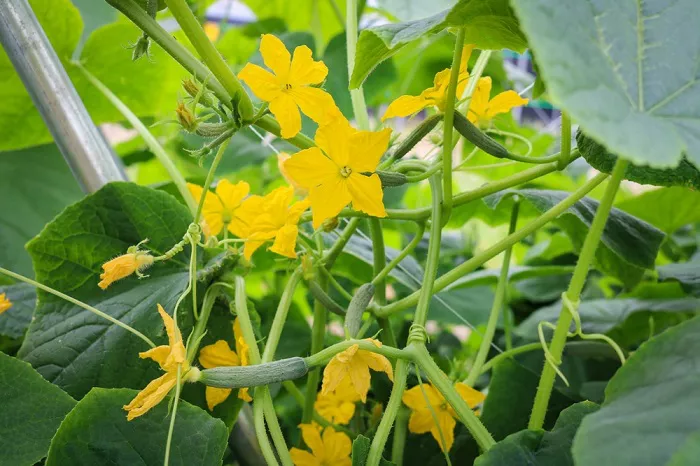Pollination is a vital process for cucumber plants, as it ensures the production of healthy and abundant fruits. Whether you are a seasoned gardener or a novice, understanding how to pollinate cucumber flowers can significantly enhance your gardening experience. This article will guide you through the essential steps and tips to effectively pollinate cucumber flowers, ensuring a bountiful harvest.
Understanding Cucumber Flower Structure
Cucumber plants produce both male and female flowers, which are essential for successful pollination. Male flowers usually appear first and in greater numbers, while female flowers have a small ovary at their base, resembling a tiny cucumber. Recognizing the difference between these flowers is crucial for effective pollination.
Identifying Male and Female Flowers
Male flowers are typically smaller and appear in clusters on the vine. They contain stamens that produce pollen. Female flowers, on the other hand, have a distinct ovary at the base and usually appear singly or in pairs. The presence of this ovary is a clear indicator of a female flower.
The Importance of Pollination
Pollination is the transfer of pollen from the male flower to the female flower, enabling fertilization and fruit development. Without proper pollination, cucumber plants may produce few or no fruits. Natural pollinators like bees and other insects often play a significant role in this process. However, in some cases, gardeners may need to intervene to ensure successful pollination.
Challenges in Pollination
Several factors can hinder the natural pollination process. Environmental conditions, such as extreme temperatures, heavy rain, or lack of pollinators, can reduce the chances of successful pollination. Additionally, certain cucumber varieties may require more attention to ensure proper fertilization.
Techniques for Hand Pollination
Hand pollination is a reliable method to ensure successful fruit set, especially when natural pollinators are scarce. This process involves transferring pollen from the male flower to the female flower manually. Here are the steps to follow:
Preparing for Hand Pollination
Before you begin, gather the necessary tools. You will need a small, soft brush or a cotton swab to transfer the pollen. Ensure that your tools are clean to avoid introducing any contaminants to the flowers.
Transferring Pollen
Select a Healthy Male Flower: Choose a male flower that has fully opened and is producing fresh pollen. Gently remove the flower from the vine.
Collect Pollen: Use the brush or cotton swab to collect pollen from the stamen of the male flower. Be careful not to damage the flower.
Locate a Female Flower: Find a female flower that has just opened. Ensure that the stigma is receptive and appears sticky.
Transfer Pollen: Gently brush the pollen onto the stigma of the female flower. Repeat this process for several female flowers to increase the chances of successful pollination.
Timing and Frequency
The best time to perform hand pollination is in the morning when the flowers are fully open and the pollen is fresh. It is recommended to repeat the process over several days to ensure that all female flowers have a chance to be pollinated.
Enhancing Pollination with Natural Methods
While hand pollination is effective, there are also ways to encourage natural pollinators to visit your cucumber plants. Creating a pollinator-friendly environment can significantly improve the chances of successful pollination.
Attracting Pollinators
Plant Companion Flowers: Planting flowers that attract bees and other pollinators near your cucumber plants can help increase their visits. Marigolds, zinnias, and sunflowers are excellent choices.
Provide a Water Source: A shallow dish of water with small stones or marbles can provide a drinking spot for pollinators, making your garden more inviting.
Avoid Pesticides: Chemical pesticides can harm pollinators. Opt for organic pest control methods to protect these beneficial insects.
Creating a Pollinator-Friendly Environment
Creating a habitat that supports pollinators involves more than just planting flowers. Providing shelter, such as small bee houses or undisturbed areas of your garden, can encourage pollinators to make your garden their home.
Monitoring and Maintaining Your Cucumber Plants
After pollination, it is essential to monitor your cucumber plants to ensure healthy fruit development. Proper care and maintenance can help prevent issues such as blossom end rot or poor fruit set.
Watering and Fertilizing
Cucumber plants require consistent watering to produce healthy fruits. Ensure that the soil remains moist but not waterlogged. Applying a balanced fertilizer regularly can also support robust plant growth and fruit development.
Pruning and Training
Pruning excess foliage and training your cucumber vines can improve air circulation and sunlight exposure. This not only helps in fruit development but also reduces the risk of diseases.
Troubleshooting Common Issues
Despite your best efforts, you may encounter some issues during the pollination process. Understanding these challenges and how to address them can help you maintain a healthy cucumber garden.
Poor Fruit Set
If your cucumber plants are not producing fruits despite successful pollination, it could be due to environmental factors such as extreme temperatures or nutrient deficiencies. Adjusting your watering and fertilizing practices can help address these issues.
Pest and Disease Management
Pests and diseases can also impact the success of pollination. Regularly inspect your plants for signs of pests such as aphids or diseases like powdery mildew. Implementing organic pest control methods and proper disease management can help keep your plants healthy.
Conclusion
Pollinating cucumber flowers is a rewarding process that can lead to a bountiful harvest. By understanding the structure of cucumber flowers, employing effective hand pollination techniques, and creating a pollinator-friendly environment, you can ensure successful fruit development. With proper care and attention, your cucumber plants will thrive, providing you with a delicious and healthy crop.


